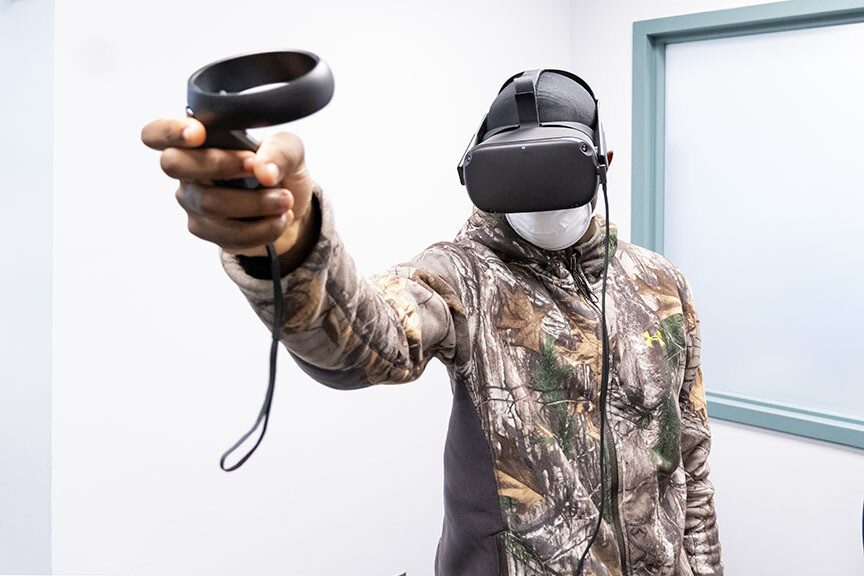Executive summary
The governor of Alabama has set an ambitious goal: Add 500,000 skilled workers to the state’s workforce to help local employers fill open roles, providing Alabamans with well-paying jobs in high-growth industries. The state’s Ready to Work programs are augmenting their classroom soft-skills and work readiness programs with technical skills delivered via Transfr’s hands-on simulations. After completing the Ready to Work program, students with the kinds of skills imparted by Transfr modules are employable and ready for on-the-job training when they step on-site.
The challenge: Create 500,000 skilled workers in Alabama
The state of Alabama is looking to create 500,000 skilled workers — that’s a big number! But workforce development teams in the Yellowhammer State aren’t sitting back and hoping for the best. Alabama has strong statewide workforce initiatives aimed at preparing their citizens for jobs in manufacturing and other high-growth, high-tech industries.
The Ready to Work program is open to any job seeker of any age and is mostly focused on soft skills and basic workplace knowledge. This program is building Alabama’s future workforce by empowering residents with job-readiness skills they will need to find and secure jobs, while delivering the foundational technical skills that employers look for in candidates. This technical skills training is delivered via Transfr’s virtual hands-on simulations.
Ambitious programs like Ready to Work, which aim to modernize workforces, need a robust array of resources to be effective! For the job seekers entering the program, personal attention and mastery of fundamental skills are essential for success. Transfr was the state’s solution to delivering both at scale!
Shelton State leverages VR training to supercharge programs
Partnering with Transfr is helping Alabaman’s learn more skills, faster, with personal attention delivered via our virtual instructor, Simon. Hands-on simulations from Transfr complement Ready to Work and JumpstartAL programs by seamlessly integrating into their curricula and delivering high-quality, repeatable trainings to their audiences, without bringing on additional staff, or the cost of expensive materials or training facility buildouts. They’re also exciting buzz-builders for the programs!
Job seekers are already using Transfr as part of their unique pathways to better lives, with 128 students in 30 classes completing 1,833 simulations at 92% mastery! Transfr’s plant safety, precision measurement, and blueprint reading simulations are important parts of this program, making Transfr a great fit that augments classroom instruction and enhances the efforts of human instructors instead of replacing them.
“Transfr is a great tool in helping provide a modern instructional approach to the precision measurement component of Ready to Work,” says Shelton State Ready to Work instructor Molly Wagner. “My students enjoy mastering the virtual simulations which incorporate many skills that are needed to succeed in today’s workforce. This technology keeps students of all ages engaged as they progress at their own pace and receive immediate feedback on their progress.”
“Transfr is a great company to work with and the technology that they have developed creates stimulating real-world experiences for students. Not only are we leveraging this cutting-edge technology to create excitement for career exploration aimed at prospective students, we are also eager to work this technology into our applicable programs to create exposure to actual work environments.”
In addition to helping instructors do their best work and reach more Alabamans, Chris added that the technological aspect is important when it comes to engaging students who have grown up in a high-tech world:
“Instruction must be interesting and relatable to students’ life situations. That’s what I think is special about Transfr: The VR content is valuable to the students who can explore and prepare for careers, some of which they might not even know existed.”
Shelton State — leading Alabama in jumpstarting workforce training
Shelton State’s engagement has been very high. Since starting work with Transfr in August of 2020, 128 students in 30 classes have gone through the program. Ready to Work is generally geared for smaller class sizes, giving job seekers more personal attention. The response from both students and faculty has been very positive.
“It was very informative and accurate with hands-on demonstrations. It gives you the chance to learn at your own pace and maintain focus on the problem solving one step at a time. I would prefer this method over all other methods,” says Liz Pruitt, a Ready to Work student at Shelton State.
This is the Transfr ethos in action: Empowering students and instructors with the highest quality training to give people the skills they need for real jobs, right now, in high-growth industries — augmenting humans is key to the success of programs like these. Real-time data from student VR sessions is immediately available to instructors who use it to tailor classroom instruction and give customized support to students when and how they need it.
Humans + technology build the future of Alabama
The promise of every stage of technological development has been to help humans do more than the impossible and help people everywhere live happier, healthier lives. In Alabama, the Jumpstart AL initiative and Ready to Work programs, augmented with Transfr hands-on simulations, are helping do just that. Human instructors give job seekers the soft skills and workplace understanding they need to find and secure employment in the growing number of high-growth jobs coming to the state. Transfr augments these programs with the hard skills training they need to learn more and earn more, preparing them to excel the first day they step onto the worksite.
“The ability to integrate competencies that can only be gained through work experience into our entry-level training programs really streamlines the preparedness of our students” says Chris. “We are currently using this technology for training that leads to employment in the manufacturing sector, but are eager to expand the use of this technology to the healthcare sector in the future. Students love it and so do our employers. We want to leverage it any place we can.”

